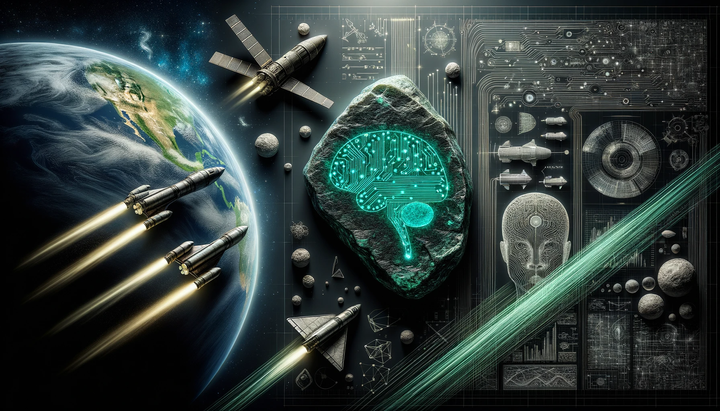Questions, Evidence, and Knowledge in Space Domain Awareness
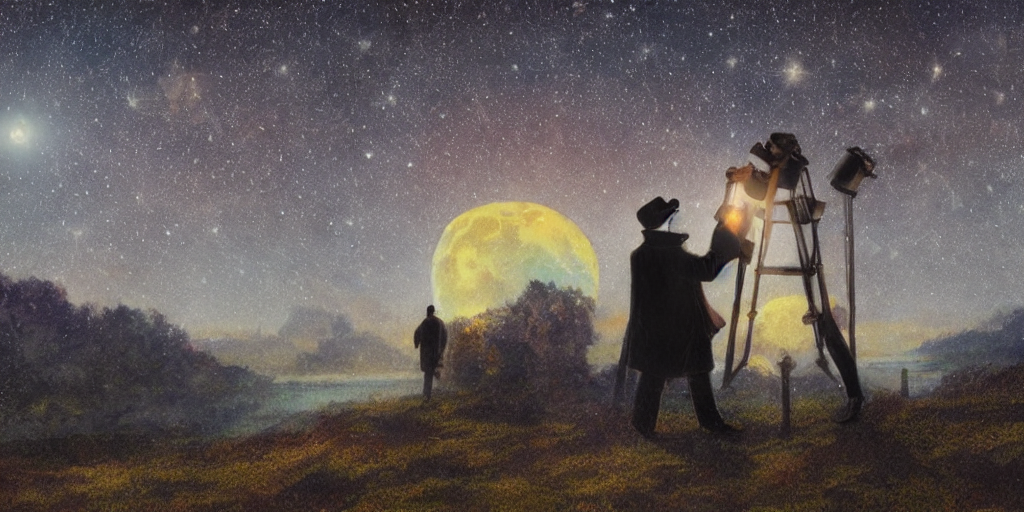
Why do we care about posing questions, fusing evidence, and producing knowledge in Space Domain Awareness? What qualities do the 'right' questions posses? How can we avoid failures of imagination in the Space Domain? What is the difference between knowledge and evidence? This article endeavors to address some of these questions.
Knowledge is a fundamental output of Space Domain Awareness, and a necessary input to decision-making. To produce knowledge and quantify its uncertainty, we must pose quality questions, and use existing information or task assets to collect evidence to resolve those questions.
The following sections describe a framework for knowledge generation and representation in Space Domain Awareness I've been developing over the past several years. It is (briefly) described here to initiate discussion and obtain feedback for further improvement.
Converting Evidence into Knowledge
Evidence / Information are often used as synonyms for knowledge. Because this article is focused on types of knowledge in the context of Space Domain Awareness, more precise definitions are necessary. The definitions use Ackoff’s 1988 data-information-knowledge-wisdom (DIKW) hierarchy as a foundation.
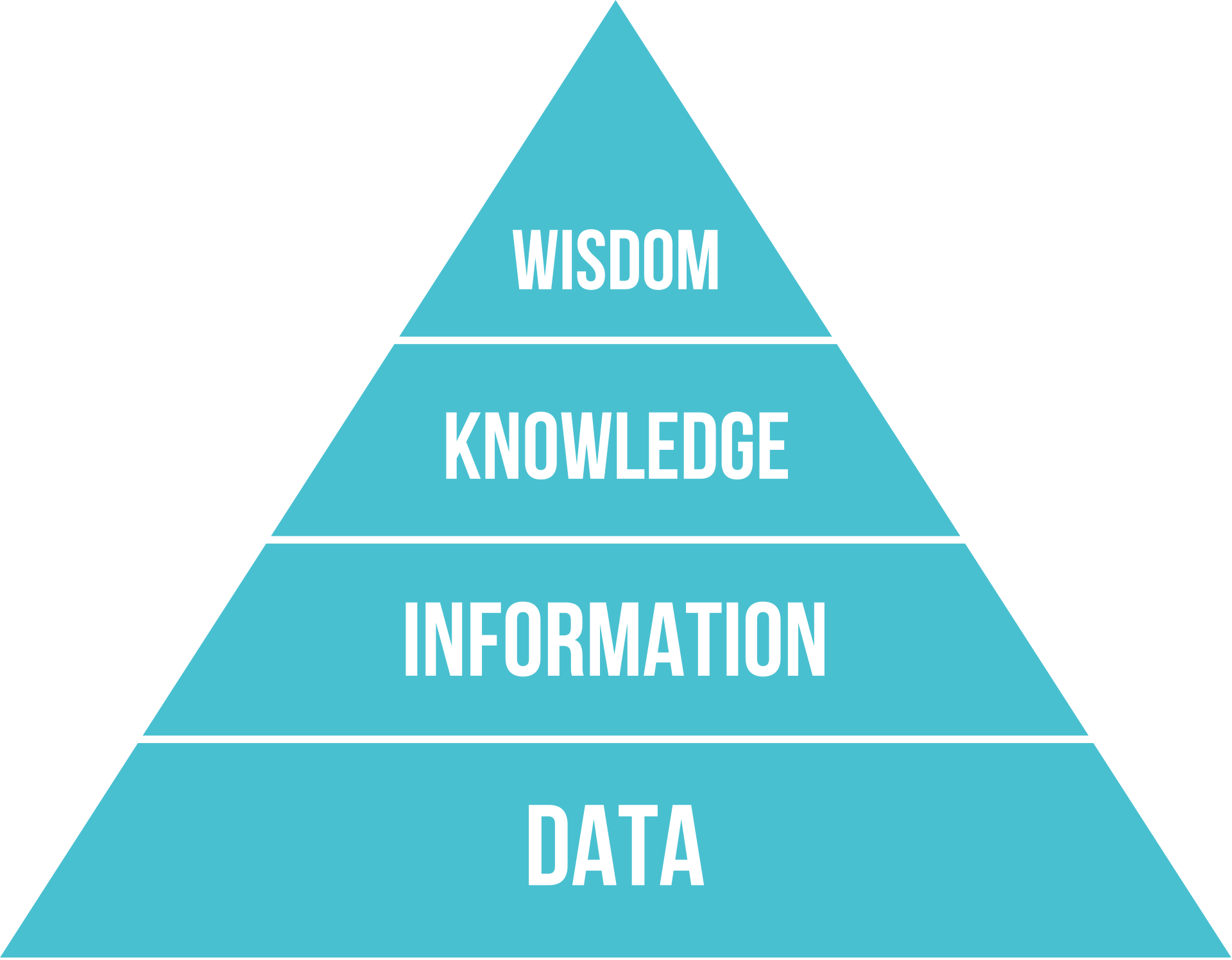
Evidence / Information. In this discussion, evidence / information is partially processed data. Evidence and information may be collected from sensor networks, social media, people, intelligence activities, or any instrument. Images from telescopes and text from internet forums are great examples of data used to produce information / evidence. For simplicity, in this article information and evidence are considered synonymous.
Knowledge. Knowledge is defined here as the output or conclusion drawn from resolving a question (or hypothesis) using evidence / information, as well as any quantified uncertainty. Let's examine a brief conceptual 3-step sequence that generates knowledge.
1) Ask a Question
A question is a necessary precursor to knowledge; to obtain knowledge, we must first ask questions. In Domain Awareness applications, we ideally ask questions that will help timely and quality decision-making. That starts with posing relevant and actionable questions. Simple examples include: "Is there an object there?" "Did a maneuver occur?"
2) Gather Evidence / Information
To answer a question, evidence / information must be collected that have a material bearing on resolving that question. Collection can mean either mining existing information (e.g., data lakes, reports) or tasking assets (such as telescopes) to gather new evidence.
3) Produce Knowledge: Resolve the Question and Quantify Uncertainty
Knowledge is the product of combining questions with evidence. This step is the province of data fusion, perception, and sense-making. Most 'magic' in Space Domain Awareness occurs here, and typically this is the most difficult step in producing knowledge. Because a variety of surrogate models and uncertainties exist in evidence / information, any produced knowledge has associated uncertainty.
Some Examples
A pair of examples can help us understand this process:
Example 1
Input:
- Question: "Is the blue car stopped at the traffic light?"
- Evidence / Information: image sequence, intersection weight sensor
Output:
- Knowledge: The blue car is stopped at the traffic light with probability 99.4%
Example 2
Input:
- Question: "Is this space object active or debris?"
- Evidence / Information: Telescope photometric (brightness) measurements over several minutes
Output:
- Knowledge: Insufficient evidence to draw a conclusion; question not resolved. Uncertainty is ambiguous.
In Example 1, the question is resolved and associated uncertainty provided. Contrasting this, Example 2 has an inconclusive output, and requires collecting more evidence / information before drawing a conclusion and quantifying uncertainty.
Knowledge and Space Domain Awareness
As stated elsewhere, the purpose of Space Domain Awareness is to enable timely and quality decision-making. Because the highest quality decisions are made when we have knowledge of relevant factors, we can use the knowledge production process above to expand on how to pursue Space Domain Awareness. In particular:
To achieve timely and quality Space Domain Awareness, we must pose the best quality questions and resolve them and their uncertainties as unambiguously as possible before decisions must be made. Timely and quality decisions require timely and quality knowledge.
In the next section representation of different types of knowledge are discussed, followed by a proposed variant of existing knowledge representations.
Knowledge Representation and Johari Windows
Johari Windows are a visualization of knowledge representation. Originally developed by Joseph Luft and Harrington Ingham (Joseph + Harrington ~= Johari), they are a 2x2 grid with two axes - one representing whether an individual possesses certain knowledge, and the other axis identifying whether others possess that knowledge.
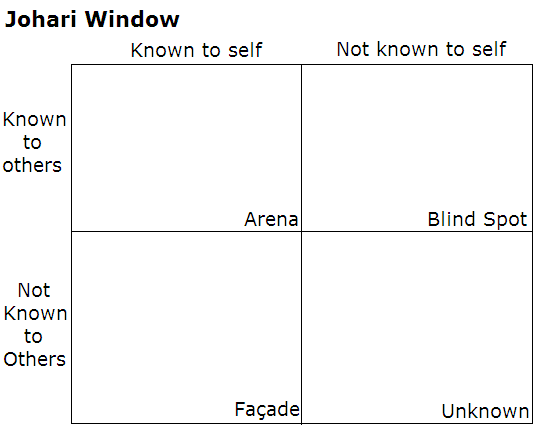
Johari Windows have a long and illustrious career of application within decision-making. Perhaps the most famous is Secretary of Defense Donald Rumsfeld's 2002 discussion during a press conference.

Below, I describe a variant of the Johari Window relevant to producing knowledge using questions and evidence / information. This depiction is similar to but expands upon a related description given in the AIAA Journal of Guidance, Dynamics, and Control by myself and Dr. Moriba Jah.
The 'Mark-H' Johari Window
For this discussion, I introduce a variant of the Johari Window that transforms the self- and other- knowledge axes into the following:
- vertical axis: Has a given question or hypothesis been formed?
- horizontal axis: Does evidence / information exist to resolve a hypothesis?
Together, these form a 2x2 grid with the following tiles and features
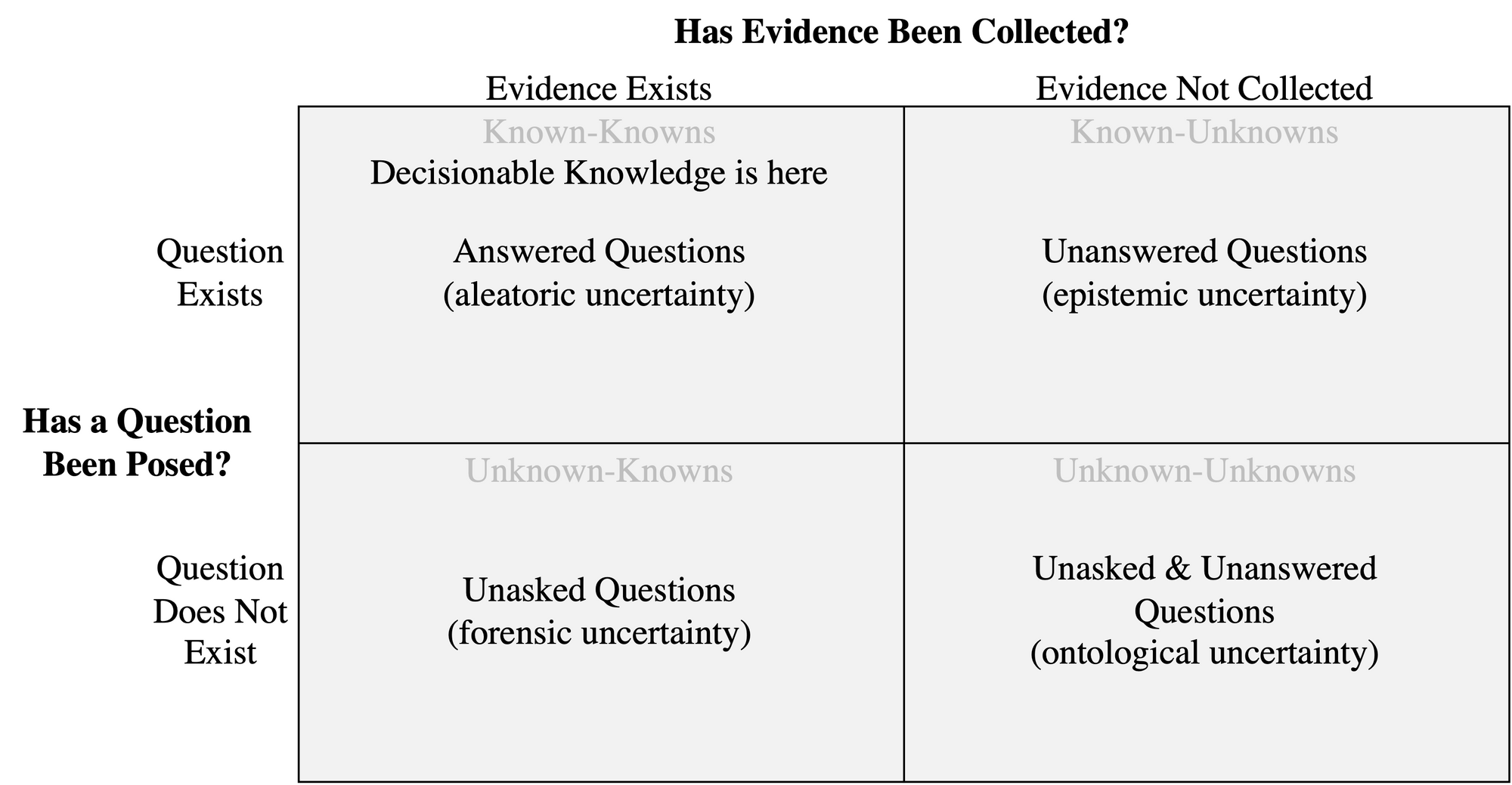
One way to think of this 'Mark-H' Johari Window is asking whether steps 1 (posing a question) and 2 (gathering evidence) have been performed, and whether we may execute step 3 (produce knowledge and quantify uncertainty.
The terms in each grid square can be difficult to internalize (especially Unknown-Knowns and Unknown-Unknowns). In an attempt to clarify, let's review brief descriptions and their associated types of uncertainty.
Known-Knowns (Answered Questions / Existing Knowledge)
These are questions that have been both articulated and resolved with evidence. This quadrant represents existing knowledge. There is often residual uncertainty related to quantitative knowledge that is irreducible, i.e., Aleatoric Uncertainty.
A goal of all knowledge generation (i.e., question-asking and evidence-collection) is to have all relevant knowledge in this quadrant.
Just because knowledge exists somewhere doesn't mean it's accessible to or digestible for relevant decision-makers. This problem is the domain of Command and Control (C2) systems, knowledge management, and cognitive engineering.
Known-Unknowns (Unanswered Questions)
These questions have been articulated, but have not yet been answered because evidence / information has not yet been collected. It remains for future activities to collect evidence to resolve the question at hand. Such knowledge has uncertainty can be reduced with further evidence, called Epistemic Uncertainty. Naturally, it may not be possible to answer some questions because evidence cannot be collected.
Unknown-Unknowns (Unasked & Unanswered Questions)
The most confounding of all types of knowledge, this quadrant represents knowledge or questions to which both the question is unknown and the knowledge has not yet been collected. The type of uncertainty representing this state is Ontological Uncertainty. Said differently, a decision-maker cannot access knowledge in this quadrant because of a failure of imagination. Knowledge in this quadrant can't be obtained because the question has not been conceived.
An approach to addressing Unknown Unknowns (Ontological Uncertainty) could include scenarios and exercises that encourage Divergent Thinking.
Unknown-Knowns (Unasked Questions / Questions we Could Answer If Asked)
These are pieces of knowledge for which evidence has already been collected that could be resolved / answered if only the question were formulated. Since the question has not been formulated and the evidence already exists to resolve it, there is an implicit uncertainty related to the question itself, here called Forensic Uncertainty.
As with Unknown-Unknowns, knowledge in this quadrant is unavailable because no-one has yet posed the question and fused available evidence. Divergent thinking provoked by exercises and simulations can mitigate this problem.
Applications
Because the 'Mark-H' Johari Windows represent types of knowledge as they relate to actionable questions and evidence, they are natural constructs within which to frame investigations (scientific or otherwise), task assets, integrate within decision-making loops (e.g., Observe, Orient, Decide, Act - OODA, the Kill Chain), and represent objectives and states of play in contests of deception. In particular, pursuit of excellent Space Domain Awareness is dependent upon decision-makers internalizing timely and quality knowledge.
Architects and operators of Space Domain Awareness systems stand to benefit substantially from internalizing the different types of knowledge described by whether the right questions have been asked, and whether evidence exists or could be collected to resolve those questions.
Summary
Where does this abstract discussion leave us? There are several principal take-aways:
- Knowledge is the product of posing a question or hypothesis, resolving it with evidence / information, and quantifying any relevant uncertainty.
- Knowledge is a fundamental output of Space Domain Awareness; timely and quality knowledge produced by Space Domain Awareness is necessary for timely and quality decision-making.
- The 'Mark-H' Johari Window provides a framework with which Space Domain Awareness architects and operators can articulate whether quality questions are being posed, and if evidence / information can be or has been collected to produce actionable knowledge.
This article is philosophical in nature - questions, comments, refutations, and constructive criticisms are welcome!
Subscribe to the Newsletter
If you enjoy this content, show your support by subscribing to the free weekly newsletter, which includes the weekly articles as well as additional comments from me. There are great reasons to do so and subscriptions give me motivation to continue writing these articles! Subscribe today!

